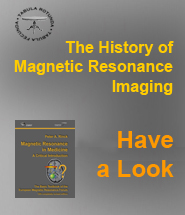Glosario
| a | b | c | d | e | f | g | h | i | j | k | l | m | n | o | p | q | r | s | t | u | v | w | x | y | z |
T
T → Tesla.
T1 ('T-one'): spin-lattice or longitudinal relaxation time; the characteristic time constant for spins to tend to align themselves with the external magnetic field. Starting from zero magnetization in the z direction, the z magnetization will grow to 63% of its final maximum value in a time T1.
T1-ρ (T-one rho): spin-lattice relaxation time in the rotating frame; the characteristic time constant for loss of magnetization of spins under the influence of a spin-locking B1 field. Despite its name T1-ρ relaxation is more closely related to T2 relaxation than T1.
T1-weighted image: image whose contrast is mainly influenced by T1, but which also has T2, proton density, and bulk flow contributions.
T2 ('T-two'): spin-spin or transverse relaxation time; the characteristic time constant for loss of phase coherence among spins oriented at an angle to the static magnetic field. Arises from interactions between the spins, with a resulting loss of transverse magnetization. The x-y magnetization will decay so that it loses 69% of its initial value in a time T2.
T2* ('T-two-star'): the characteristic time constant for loss of phase coherence among spins oriented at an angle to the static magnetic field due to a combination of magnetic field inhomogeneities, and spin-spin transverse relaxation with resultant increase in the loss of transverse magnetization and NMR signal. NMR signal can still be recovered as a spin echo.
T2-weighted image: image whose contrast is mainly influenced by T2, but which also has T1, proton density, and bulk flow contributions.
Tagging → Spin tagging.
Tailored excitation → Selective excitation.
Tailored pulse: shaped pulse whose magnitude is varied with time in a predetermined manner. Affects the frequency components of an RF pulse in a manner approximately determined by the Fourier transform of the pulse for simpler pulse shapes.
TE: echo time. Time between middle of 90° pulse and middle of spin echo production.
Tesla (T): the SI unit of magnetic flux density. One Tesla is equal to 10,000 Gauss, the older (CGS) unit.
Thermal equilibrium: a state in which all parts of a system are at the same effective temperature. In particular it is where the relative alignment of the spins with the magnetic field is determined solely by the thermal energy of the system (in which case the relative numbers of spins with different alignments will be given by the Boltzmann distribution).
Three-dimensional imaging (3-D imaging) → Volume imaging.
TI: inversion time. Time after middle of inverting RF pulse to middle of 90° pulse used to monitor the amount of longitudinal magnetization.
Torque: the effectiveness of a force in setting a body into rotation. It is a vector quantity given by the vector product of the force and the position vector where the force is applied; for a rotating body, the torque is the product of the moment of inertia and the resulting angular acceleration.
TR: repetition time. The period of time between the beginning of a pulse sequence and the beginning of the succeeding (essentially identical) pulse sequence.
Train → Echo train.
Transmitter: portion of the NMR apparatus that produces RF current and delivers it to the transmitting coil.
Transmitter coil: coil which delivers RF from the transmitter to the sample being examined.
Transverse coherences: if RF pulses are repeated at intervals which are less than T2 then they can act both as excitation and refocusing pulses since in addition to generating fresh transverse magnetization they can refocus all or part of the signal from preceding RF pulses. This can lead to the formation of spin echoes centred on the RF pulses which supplement the newly created transverse magnetization.
Transverse magnetization (Mxy): component of the macroscopic magnetization vector at right angles to the static magnetic field (B0). Precession of the transverse magnetization at the Larmor frequency is responsible for the detectable NMR signal. In the absence of externally applied RF energy, the transverse magnetization will decay to zero with a characteristic time constant of T2*.
Transverse relaxation time → T2.
Two-dimensional Fourier transform imaging (2DFT): a form of sequential plane imaging using Fourier transform imaging .
Tuning: process of adjusting the resonance frequency, e.g., of the RF circuit, to a desired value, e.g. the Larmor frequency. More generally, the process of adjusting the components of the spectrometer for optimal NMR signal strength.
Missing terms? Send us an e-mail. We'll add them ...












